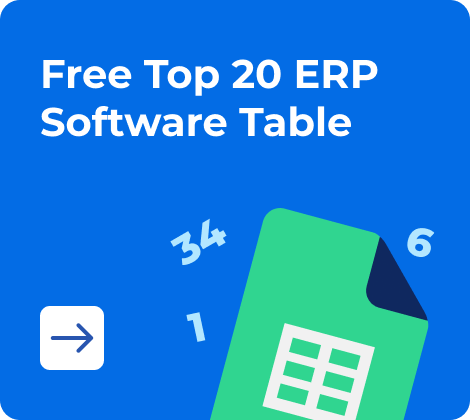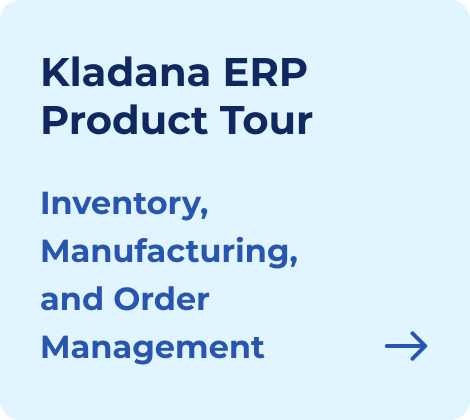Navigating modern business management often requires choosing the right tools. Among the most critical are Material Requirements Planning (MRP) and Enterprise Resource Planning (ERP). Though similar, MRP and ERP serve distinct purposes. Understanding their key differences is crucial for optimizing processes, reducing costs, and staying competitive. This guide will help you decide between MRP and ERP for your business.
Not sure whether you need ERP or MRP — or anything at all?
Our ERP software comparison table will help you find clarity. See the features, support options, and modules side by side — and get a free 30‑day trial of Kladana to try things out hands‑on.
What is MRP?
Material Requirements Planning (MRP) is used mainly by manufacturers to manage production processes. MRP systems ensure that materials and components are available at the right time and in the right quantities. It focuses on planning and scheduling, from procuring raw materials to delivering finished goods, and coordinating the entire supply chain. MRP is an essential tool for coordinating the entire supply chain, enabling manufacturers to meet customer demands efficiently while minimizing inventory costs and reducing waste.
MRP operates on three principles: determining what materials are needed, calculating quantities, and timing procurement. It relies on data inputs like the master production schedule, bill of materials (BOM), and inventory records. The master production schedule outlines what and when products need to be produced. The BOM lists all components needed for production, while inventory records track stock levels.
A key benefit of MRP is optimizing inventory management by accurately forecasting material demand. This prevents overstocking, which ties up capital and increases storage costs, and understocking, which causes production delays and missed deadlines. MRP strikes a balance, ensuring materials are available when needed while minimizing excess inventory, contributing to cost savings and improved cash flow.
MRP also enhances production planning by generating detailed schedules based on the master production schedule and BOM. It considers lead times, production capacities, and bottlenecks, streamlining operations, reducing cycle times, and increasing efficiency.
Another advantage is improved supplier coordination. MRP systems enable early communication with suppliers, reducing supply chain disruptions. By maintaining accurate inventory records, MRP helps manufacturers identify shortages or excesses in real-time and take corrective actions.
MRP contributes to better decision-making by providing insights into material usage, production efficiency, and supplier performance. Integrated with ERP systems, MRP offers a comprehensive view of business operations, aligning production with other activities like sales forecasting and budgeting.
In summary, MRP software is vital for manufacturing companies, optimizing inventory, streamlining schedules, enhancing supplier coordination, and supporting informed decision-making. MRP remains essential for staying competitive in an evolving market.
Read‑alikes
ERP Inventory Management: 12 Benefits for Your Business in Full Guide
Top 20 ERP Software for SMEs in India and Across the World 2025
Managing Production in a Small Manufacturing Company: Planning, Control, and Profit Calculation
What is ERP?
Enterprise Resource Planning (ERP) unifies an organization’s core processes across departments. Unlike specialized systems, ERP offers a centralized platform integrating all business aspects, from finance and accounting to supply chain management, HR, and customer relationship management. This integration enables seamless communication and data sharing, improving overall efficiency.
ERP software acts as a cohesive information hub, consolidating data from different departments in real‑time. For example, when a sale is made, the ERP system updates inventory, generates financial records, and informs production. This real‑time synchronization minimizes errors, reduces redundancies, and speeds up processes, ensuring all departments work with up‑to‑date information.
ERP systems automate routine tasks, reducing manual intervention and the likelihood of errors. This allows employees to focus on strategic activities, like data analysis for informed decision-making.
ERP systems are customizable and scalable, adapting to specific industry needs and growing with the organization. They incorporate advanced technologies like AI and predictive analytics for deeper insights and more accurate forecasts.
ERP also enhances compliance and governance by providing tools for tracking regulatory requirements and generating compliance reports. This ensures businesses meet legal obligations while minimizing risks.
In conclusion, ERP integrates, automates, and optimizes core business processes. With real‑time insights, customization, scalability, and advanced technologies, ERP systems are crucial for maintaining a competitive edge.
Learn How to Automate Your Business with Kladana ERP
- End‑to‑end ERP — manage inventory, production & sales
- Smooth onboarding — 1–3 sessions
- Quick support response — 5–15 minutes
- Flexible solution — unlimited API and seamless integrations
- Dependable infrastructure — fully-managed and secure cloud-based software
Key Differences Between MRP and ERP
When evaluating enterprise systems, understanding the key differences between Material Requirements Planning (MRP) and Enterprise Resource Planning (ERP) is crucial.
| Feature/Aspect | MRP (Material Requirements Planning) | ERP (Enterprise Resource Planning) |
Primary Focus |
Manufacturing processes, inventory management, and production planning. |
Integration of all business processes, including finance, HR, CRM, supply chain, and more. |
Scope |
Limited to production and inventory management. |
Broad, covering the entire organization. |
Implementation |
Typically standalone or a module within an ERP system. |
Comprehensive system integrating various departments and functions. |
Purpose |
Optimize production schedules and material availability. |
Unify all business processes into a single, cohesive system. |
Complexity |
Simpler, focused on specific manufacturing needs. |
More complex, designed to handle various business processes. |
Scalability |
Less scalable, suitable for small to medium-sized manufacturers. |
Highly scalable, adaptable to the growing needs of an organization. |
Integration Capabilities |
Limited integration with other systems. |
Strong integration across departments, offering real-time data and comprehensive reporting. |
User Base |
Primarily used by manufacturing teams. |
Used by a wide range of departments, including finance, HR, sales, and customer service. |
Data Management |
Focused on production and inventory data. |
Centralized data management across the entire organization. |
Reporting & Analysis |
Requires additional tools for comprehensive reporting. |
Advanced reporting and analysis capabilities, providing real‑time insights. |
Ideal For |
Manufacturers focusing on optimizing production efficiency. |
Organizations seeking to integrate all business processes for better overall efficiency. |
📊 Get the ERP Comparison Table + 30‑Day Free Trial
Fill out the form for instant access to the comparison table + a Kladana trial code.
Frequently Asked Questions on Choosing between MRP and ERP
When deciding between Material Requirements Planning (MRP) and Enterprise Resource Planning (ERP) systems, many businesses face common questions. Understanding the distinctions between MRP and ERP can help in making an informed choice.
What is the primary difference between MRP and ERP systems?
MRP systems focus primarily on production planning and inventory control, ensuring that materials are available for production and that production schedules are met. ERP systems, on the other hand, encompass a broader range of business processes, including finance, human resources, supply chain management, customer relationship management, and more. ERP integrates all these functions into a single system, providing a comprehensive view of the business, while MRP is more specialized in manufacturing processes.
Which system is better for small to medium‑sized businesses (SMBs)?
For SMBs, the choice between MRP and ERP depends largely on the complexity of their operations. If a business primarily needs to manage production schedules, inventory levels, and materials planning, an MRP system might suffice. However, if the business requires a more integrated approach that includes managing financials, customer relationships, and human resources, an ERP system would be more beneficial. Many modern ERP systems offer modular options, allowing SMBs to start with core functionalities and expand as their needs grow.
Can an MRP system be integrated with other business software?
Yes, MRP can integrate with other software, but ERP offers seamless integration across functions. Choosing an ERP system can eliminate the need for multiple software solutions, reducing complexity and potential integration challenges.
How do these systems handle data and reporting?
MRP generates production-related reports but may lack comprehensive business insights. ERP excels in data management and reporting across departments.
What are the implementation challenges for each system?
Implementing an MRP system is generally less complex than an ERP system due to its narrower focus. MRP implementation typically involves setting up production planning parameters, defining inventory levels, and configuring schedules. However, ERP implementation is more extensive, requiring a thorough analysis of all business processes to ensure successful integration across departments. While ERP implementation may take longer and require more resources, the long‑term benefits of having an integrated system often outweigh the initial challenges.
Are cloud‑based options available for both MRP and ERP?
Yes, cloud‑based solutions are available for both MRP and ERP systems. Cloud‑based MRP systems offer flexibility, scalability, and accessibility, making them a popular choice for businesses looking to streamline their manufacturing processes without investing heavily in on‑premise infrastructure. Similarly, cloud‑based ERP systems provide the same benefits but on a larger scale, covering all aspects of the business. Cloud‑based ERP systems also offer the advantage of regular updates, enhanced security, and lower upfront costs compared to traditional on‑premise solutions.
How do these systems support compliance and regulatory requirements?
MRP supports compliance within manufacturing. However, they may not offer comprehensive support for broader regulatory requirements, such as financial reporting or data protection. ERP systems, with their integrated approach, are better equipped to handle compliance across various functions, ensuring that all aspects of the business meet regulatory standards.
Which system offers better scalability?
While both MRP and ERP systems offer scalability, ERP systems are generally more scalable due to their modular nature. Businesses can start with core modules and add functionalities as needed, allowing the system to grow with the business. MRP systems, while scalable within the manufacturing domain, may require additional software to manage other business areas as the company expands. For businesses planning for long‑term growth, an ERP system provides a more scalable solution that can adapt to changing needs.
What is the cost difference between MRP and ERP systems?
MRP systems are less expensive due to their narrower focus, while ERP systems have higher costs but offer greater ROI due to integration.
How do these systems affect business efficiency and productivity?
MRP systems improve efficiency by optimizing production processes, reducing waste, and ensuring that materials are available when needed. They are essential for manufacturing businesses looking to streamline operations and meet production deadlines. ERP systems, on the other hand, enhance overall business efficiency by integrating all departments into a single system, reducing duplication of effort, improving communication, and providing real‑time data for better decision-making. For businesses looking to optimize not just manufacturing but all aspects of their operations, an ERP system offers greater benefits in terms of productivity and efficiency.
In conclusion, choosing between MRP and ERP depends on the specific needs of your business. If your focus is solely on manufacturing and inventory management, an MRP system may be sufficient. However, if you require a more comprehensive solution that integrates all business processes, an ERP system is the better choice. Consider your business size, complexity, growth plans, and budget when making your decision.


